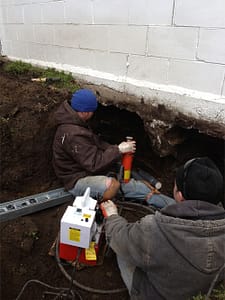How Best Basement Waterproofing can Save You Time, Stress, and Money.
The Basic Principles Of Best Basement Waterproofing
Table of ContentsThe Ultimate Guide To Best Basement WaterproofingThe Main Principles Of Best Basement Waterproofing Best Basement Waterproofing Can Be Fun For AnyoneA Biased View of Best Basement WaterproofingFascination About Best Basement Waterproofing
AdvantaClean's experienced experts and professionals will situate the water source. If wall surface or slab cracks are existing, we will certainly inject polyurethane and epoxies right into the fractures and secure the concession, preventing further wetness from entering.If there's condensation outside of the aluminum foil, you have high moisture in your cellar. Repair it with a mobile space dehumidifier or a whole-house humidifier system rather of waterproofing items. If the foil has condensation on the inside surface (alongside the wall), the soil around your home may be naturally damp from a high water table or poor soil water drainage.
You can waterproof just your interior walls, which may solve the issue. Once they dry out, they stick completely to concrete and stonework wall surfaces.
The Only Guide for Best Basement Waterproofing
Concrete water-proof finishes can't be used to previously repainted surfaces; check the label. Recognized as densifiers, they are suitable just for wall surfaces that have not been painted or secured.
But you clean, roll, or spray it on a lot more heavily one gallon covers just 75 square feet, not the 300 square feet common with common paint. Water-proof paint is fine for DIY application. You can apply it over painted surface areas, and paint over it once it's cured (one gallon expenses $37).
It can cost $10,000 to $15,000, relying on the job required. Exterior waterproofing includes excavating all over your house fully depth of the foundation walls, then mounting a waterproof covering or membrane layer topped by water drainage panels. The panels give a simple path for water to stream to an external French drain at the base view publisher site of your structure.
A basement without waterproofing is kind of like that. Your basement doesn't desire to go via a rainstorm without appropriate protection simply as much as you do not want to.
6 Simple Techniques For Best Basement Waterproofing
If you have actually done your research, you 'd know there are 2 types of waterproofing: inside and outside. It can obtain perplexing what they both mean, which one's a much better financial investment, and what will in fact maintain the water out. Don't fret, we put together this blog site to quickly specify both methods for you and discuss the pros and disadvantages of each.
Outside waterproofing is a waterproofing method that entails securing your home from the outside. The foundation walls are then cleaned up, secured, and covered with a water resistant membrane layer or sealant.

Things about Best Basement Waterproofing
It's a much more engaged process that calls for digging up your backyard, which is expensive and lengthy. Exterior waterproofing involves removing every little thing bordering the home, including verandas, driveways, walkways, landscaping, a/c devices, decks, and so forth. If any of the work was done inaccurately and water is still entering your cellar, there isn't much you can do to correct or fix it.
Interior cellar waterproofing entails waterproofing from the within. Any type of water that leakages right into your basement is rerouted before it touches your flooring. It's kind of like putting on a raincoat under your clothing. It includes 2 points: a water drain track and a sump pump. It functions by sealing the inside of your cellar walls and floors so water that tries to enter is directed out with a sump pump.
It's an effective approach to waterproof your basement - Best Basement Waterproofing. The disadvantage of interior cellar waterproofing mostly has to do with the installment procedure. This approach needs saved things, furniture, and integrated shelving or closets to be relocated from touching the cellar walls. And throughout installment, your cellar can't be made use of. The largest distinction between the 2 techniques is this: Outside waterproofing is a preventative service and interior waterproofing is a corrective solution.
What Does Best Basement Waterproofing Do?
In conclusion, outside and interior basement waterproofing are both efficient techniques of shielding your Full Article home from water damage. Exterior waterproofing creates a barrier that prevents water from entering your home, while interior waterproofing reroutes water that does enter your home. And it is very important to note that outside waterproofing is a costly and turbulent setup procedure when compared to interior waterproofing.
Whichever approach you choose, make sure you select a reputable and trustworthy specialist for the job. If you have any inquiries regarding basement waterproofing, please reach out to us.
You can fill in our type here, begin a conversation in the lower right-hand edge, or call us at 1-800-827-0702.